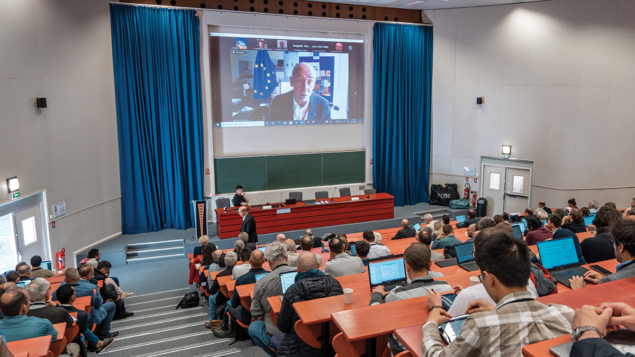
More than 500 participants from over 30 countries attended the annual meeting of the Future Circular Collider (FCC) collaboration, which is pursuing a feasibility study for a visionary post-LHC research infrastructure at CERN. Organised as a hybrid event at Sorbonne University in Paris from 30 May to 3 June, the event demonstrated the significant recent progress en route to the completion of the feasibility study in 2025, and the technological and scientific opportunities on offer.
In their welcome talks, Ursula Bassler (CNRS) and Philippe Chomaz (CEA), chair of the FCC collaboration board, stressed France’s long-standing participation in CERN and reaffirmed the support of French physicists and laboratories in the different areas of the FCC project. CERN Director-General Fabiola Gianotti noted that the electron–positron stage, FCC-ee, could begin operations within a few years of the end of the HL-LHC – a crucial step in keeping the community engaged across different generations – while the full FCC programme would offer 100 years of trailblazing physics at both the energy and intensity frontiers. Beyond its outstanding scientific case, FCC requires coordinated R&D in many domains, such as instrumentation and engineering, raising opportunities for young generations to contribute with fresh ideas. These messages echoed those in other opening talks, in particular by Jean-Eric Paquet, director for research and innovation at the European Commission, who highlighted FCC’s role as a world-scale research infrastructure that will allow Europe to maintain its leadership in fundamental research.
A new era
Ten years after the discovery of the Higgs boson, the ATLAS and CMS collaborations continue to establish its properties and interactions with other particles. The discovery of the Higgs boson completes the Standard Model but leaves many questions unanswered; a new era of exploration has opened that requires a blend of large leaps in precision, sensitivity and eventually energy. Theorist Christophe Grojean (DESY) described how the diverse FCC research programme (CERN Courier May/June 2022 p23) offers an extensive set of measurements at the electroweak scale, the widest exploratory potential for new physics, and the potential to address outstanding questions such as the nature of dark matter and the origin of the cosmic matter–antimatter asymmetry.
In recent months, teams from CERN have worked closely with external consultants and CERN’s host states to develop a new FCC layout and placement scenario (CERN Courier May/June 2022 p27). Key elements include the effective use of the European electricity grid, the launch of heat-recovery projects, cooling, agriculture and industrial use – as well as cutting-edge data connections to rural areas. Parallel sessions at FCC Week focused on the design of FCC-ee, which offers a high-luminosity Higgs and electroweak factory. Tor Raubenheimer (SLAC) showed it to be the most efficient lepton collider for energies up to the top-quark mass threshold and highlighted its complementarity to a future FCC-hh. Profiting from the FCC-ee’s high technological readiness, ongoing R&D efforts aim to maximise the efficiency and performance while optimising its environmental impact and operational costs. Many sessions were dedicated to detector development, where the breadth of new results showed that the FCC-ee is much more than a scaled-up version of LEP. It would offer unprecedented precision on Higgs couplings, electroweak and flavour variables, the top-quark mass, and the strong coupling constant, with ample discovery potential for feebly interacting particles. Participants also heard about the FCC-ee’s unique ability in ultra-precise centre-of-mass energy measurements, and the need for new beam-stabilisation and feedback systems.
The FCC programme builds on the large, stable global community that has existed for more than 30 years at CERN and in other laboratories worldwide
High-temperature superconductor (HTS) magnets are among key FCC-ee technologies under consideration for improved energy efficiency, also offering significant potential societal impact. They could be deployed in the FCC-ee final-focus sections, around the positron-production target, and even in the collider arcs. Another major focus is ensuring that the 92 km-circumference machine’s arc cells are effective, reliable and easy to maintain, with a complete arc half-cell mockup planned to be constructed by 2025. The exploration of existing and alternative technologies for FCC-ee is supported by two recently approved projects: the Swiss accelerator R&D programme CHART, and the EU-funded FCCIS design study. The online software requirements for FCC-ee are dominated by an expected physics event rate of ~200 kHz when running at the Z pole. Trigger and data acquisition systems sustaining comparable data rates are already being developed for the HL-LHC, serving as powerful starting points for FCC-ee.
Looking to the future
Finally, participants reviewed ongoing activities toward FCC-hh, an energy- frontier 100 TeV proton–proton collider to follow FCC-ee by exploiting the same infrastructure. FCC-hh studies complement those for FCC-ee, including the organisation of CERN’s high-field magnet R&D programme and the work of the FCC global conductor-development programme. In addition, alternative HTS technologies that could reach higher magnetic fields and higher energies while reducing energy consumption are being explored for FCC’s energy-frontier stage. The challenges of building and operating this new infrastructure and the benefits that can be expected for society and European industry were also discussed during a public event under the auspices of the French Physical Society.
The FCC programme builds on the large, stable global community that has existed for more than 30 years at CERN and in other laboratories worldwide. The results presented during FCC Week 2022 and ongoing R&D activities will inspire generations of students to learn and grow. Participants from diverse fields and the high number of junior researchers who joined the meeting underline the attractiveness of the project. Robust international participation and long-term commitment to deliver ambitious projects are key for the next steps in the FCC feasibility study.








